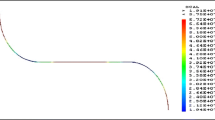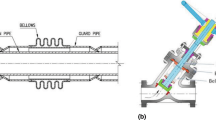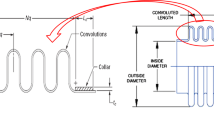Abstract
Bellows are thin, flexible shell structures generally made from thin metallic sheets by hydroforming process. Bellows are generally used to provide additional flexibility in shell structures such as piping and heat exchangers. U-shaped bellows are most commonly employed to provide flexibility. One of the intended applications of metallic bellows is in the area of high-temperature and high-pressure valves. These bellows are used for sealing as well as actuation purpose in valves. Hot shutdown passive valves are planned to be used in advanced nuclear reactors to have inherent safety feature. The design of bellows is typically carried out as per the procedure recommended by Expansion Joints Manufactures Association standard. The semiempirical equations suggested by Expansion Joints Manufactures Association are used to estimate the stresses and fatigue life of bellows. Expansion Joints Manufacturers Association does not consider the effect of plasticity in the equations for the calculation of stresses and fatigue life. The bellows have complex shape, and the loading conditions in the bellows generally produce a multi-axial state of the stress. When bellows are subjected to cyclic displacement loading, the strains are usually well beyond the proportional limit of the material. Therefore, life of the bellows is typically governed by fatigue behaviour. In this study, the Masing behaviour of SS321 material was analysed and the calibration for the Chaboche constants was performed. Finite element analyses of bellows were carried out using elastic, bilinear and Chaboche material models, with and without considering the effect of geometric non-linearity. The linearized meridional membrane and bending stresses, working spring rate of the bellows and strain amplitude data were extracted from the finite element analysis of the bellows. The Expansions Joints Manufactures Association standards stress equations overestimate the stresses, which leads to conservative design. The working spring rate of bellows was accurately predicted using the Chaboche model. The strain amplitude data obtained from finite element analysis were used in the Basquin and Coffin–Manson equation to predict the fatigue life of bellows. The fatigue life was underestimated in case of all the material models, i.e., elastic, bilinear and Chaboche model.










Similar content being viewed by others
Data Availability
Data will be shared on request.
Code Availability
Yes (software application).
References
Anderson W (1964) Analysis of stresses in bellows: design criteria and test results. Atom Int
Anderson M, Bridier F, Gholipour J, Jahazi M, Wanjara P, Bocher P, Savoie J (2016) Mechanical and metallurgical evolution of stainless steel 321 in a multi-step forming process. J Mater Eng Perform 25(4):1526–1538. https://doi.org/10.1007/s11665-016-1928-4
Becht C IV (2000) Fatigue of bellows, a new design approach. Int J Press Vessels Pip 77(13):843–850. https://doi.org/10.1016/S0308-0161(00)00078-8
Becht IV C (2002) An evaluation of EJMA stress calculations for unreinforced bellows. J Press Vessel Technol Trans ASME 124(1):124–129. https://doi.org/10.1115/1.1426405
Christ HJ, Mughrabi H, Martínez-Pañeda E, del Busto S, Li X-WW, Niordson CF, Gangloff RP, Castelluccio GM, McDowell DL, Li P, Li SX, Wang ZG, Zhang ZF, Marnier G, Keller C, Taleb L, Guo W-WW, Wang X-MM, Huang HL, Kato M (2017) Cyclic stress-strain response and microstructure under variable amplitude loading. Metall Mater Trans A 93(5):2759–2768
EJMA, 9th edition (2008) Expansion Joint Manufacturers Association, INC
Goyal S, Gupta SK, Sivaprasad S, Tarafder S, Bhasin V, Vaze KK, Ghosh AK (2013) Low cycle fatigue and cyclic plasticity behavior of Indian PHWR/AHWR primary piping material. Proced Eng 55:136–143. https://doi.org/10.1016/j.proeng.2013.03.232
Hamada M, Tanaka M (1978) Design of u-shaped bellows considering low-cycle fatigue. J Pressure Vessel Technol Trans ASME 100(4):382–388. https://doi.org/10.1115/1.3454485
Krovvidi SK, Goyal S, Bhaduri AK (2021) Experimental and numerical investigation of high-temperature low-cycle fatigue and creep-fatigue life of bellows. J Mater Eng Perform 30(4):2742–2750
Li Y, Sheng S (1990) Strength analysis and structural optimization of U-shaped bellows. Int J Press Vessels Pip 42(1):33–46. https://doi.org/10.1016/0308-0161(90)90053-K
Li W, Yang L, Li C, Chen H, Zuo L, Li Y, Chen J, He J, Zhang SD (2020) Low-cycle fatigue and fracture behavior of aluminized stainless steel AISI 321 for solar thermal power generation systems. Metals 10(8):1–17. https://doi.org/10.3390/met10081089
Sapra MK, Kundu S, Pal AK, Vijayan PK, Vaze KK, Sinha RK (2015) Design and development of innovative passive valves for Nuclear Power Plant applications. Nucl Eng Des 286(2014):195–204. https://doi.org/10.1016/j.nucengdes.2015.02.022
Sinha RK, Kakodkar A (2006) Design and development of the AHWR-the Indian thorium fuelled innovative nuclear reactor. Nucl Eng Des 236(7–8):683–700. https://doi.org/10.1016/j.nucengdes.2005.09.026
Subramanian G, Raghunandan C (1994) On improving the fatigue life of U-form bellows. J Mater Process Tech 41(1):105–114. https://doi.org/10.1016/0924-0136(94)90179-1
Tsukimori K, Yamashita T, Kikuchi M, Iwata K, Imazu A (1992) Fatigue and creep-fatigue life evaluation of U-shaped bellows. J Press Vessel Technol Trans ASME 114(3):280–291. https://doi.org/10.1115/1.2929042
Wójcik M, Skrzat A (2020) The application of Chaboche model in uniaxial ratcheting simulations. Adv Manuf Sci Technol 44(2):57–61. https://doi.org/10.2478/amst-2019-0010
Funding
BARC/DAE.
Author information
Authors and Affiliations
Contributions
All the simulations were conducted by Mr. Aakash and the manuscript was prepared jointly by the author and the co-authors.
Corresponding author
Ethics declarations
Conflict of interest
The authors declare that they have no known competing financial interests or personal relationships that could have appeared to influence the work reported in this paper.
Ethics approval
Yes.
Consent to participate
Yes.
Consent for publication
Yes.
Additional information
Publisher's Note
Springer Nature remains neutral with regard to jurisdictional claims in published maps and institutional affiliations.
Rights and permissions
About this article
Cite this article
Aakash, Dureja, A.K., Khan, I.A. et al. Finite Element Analysis of Metallic Bellows Considering Material and Geometric Non-linearity. Trans Indian Natl. Acad. Eng. 7, 645–655 (2022). https://doi.org/10.1007/s41403-021-00303-1
Received:
Accepted:
Published:
Issue Date:
DOI: https://doi.org/10.1007/s41403-021-00303-1




